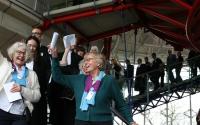Nuclear power is back on the agenda in a big way. US president George Bush wants Congress to make it easier to build nuclear plants, the newly appointed UK cabinet is expected to consider plans for a nuclear renaissance, and at the OECD forum last week in Paris, France, advocates of nuclear power argued passionately that it is the only way to curb global warming.
Countries in North America and Europe (with the exception of France and Finland) turned their backs on nuclear power following the nuclear accidents of the 1970s and 1980s and rising public concern over what to do with radioactive waste. Today, with global warming a major issue, the fact that nuclear plants generate far less carbon dioxide than fossil-fuel plants has given nuclear companies a new selling point - at least in Europe. So should we dust off nuclear power and give it another try?
To answer that question we need to think about what we really want from our energy sources. We want them to have a small environmental impact, yet be able to supply energy on a huge scale. We want costs to be low, the method of generation to be safe and for there to be plenty of available fuel. The International Energy Agency estimates that two-thirds of the extra energy demand over the next 25 years will come from developing countries, so whatever sources we choose must be tradable worldwide. Also, in the post-9/11 world, we want energy sources that cannot be abused by terrorists or rogue states.
Nuclear scores high on its low CO2 emissions, but it loses out by leaving a nasty legacy: its high-level radioactive waste needs to be secured for tens of thousands of years. Despite 40 years of assurances from the nuclear industry that this is an "engineering problem" no one has solved it. And it scarcely makes sense to generate more waste when we cannot dispose of what we already have.
Another bugbear for nuclear power is that it appears to be expensive. Its costs have never been calculated to everyone's satisfaction, partly because government subsidies have muddied the water and partly because "back-end" costs for such things as waste disposal are uncertain. Nuclear power has certainly not won round free-market investors: no plants have built within deregulated electricity markets.
Perhaps nuclear's biggest disadvantage is international security. The level of confidence in the Nuclear Non-Proliferation Treaty and nuclear safeguards is low. North Korea is the latest country to show how easy it is to divert nuclear fuel to make weapons, while nuclear sites are likely to remain targets for terrorists. Such concerns limit where plants can be built.
So are there alternatives to nuclear? The cheapest option by far is to improve energy efficiency by using waste heat from power plants, say. Then there are renewable energy sources, which suffer none of nuclear's disadvantages, though they have problems of their own.
The chief criticism of renewables is that they will never supply energy on the scale needed. It is true that wind power alone will never do the job. But add in tidal power, micro-hydro and biomass, and the problem starts to disappear. Wind power and biomass are nearly as cheap as coal while other renewables, such as wave power and photovoltaic cells, are moving steadily towards competitiveness.
The environmental impact of renewables is generally low, though wind farms have run into problems, especially with people who do not want them spoiling rural views. But there are ways around this, such as building wind farms offshore or siting single or small numbers of turbines near towns, effectively recreating the medieval pattern of windmills.
Perhaps the best evidence of the potential of renewables comes from Germany. It wants to phase out nuclear power by 2025, so is switching rapidly to other sources. It already generates more than 8 per cent of its electricity from renewables, such as wind and biomass, and is the world's largest user of photovoltaic cells. It is on target for renewables to supply half of all its energy needs by 2050, reducing its carbon emissions to a fifth of their 1990 levels.
Given our limited resources, we must put our money behind the best global solution. Rather than reinvent nuclear plants, we must move towards leaner, more localized, sustainable ways to generate energy. That means more research and development into energy efficiency and renewables and a determined campaign to deploy them.
Six Sites Finalists for Nuclear Power Plants MSNBC
Friday 20 May 2005 US consortium's list could be step toward renaissance.
Nuclear power consortium NuStart Energy on Thursday named the sites from which it will later pick two for which to apply for licenses to build and operate nuclear power plants.
Four of the six already house operating nuclear power plants. The sites, by location, are: Scottsboro, AL The Bellefonte Nuclear Plant, an unfinished site owned by the US government's Tennessee Valley Authority. Port Gibson, MS The Grand Gulf Nuclear Station, owned by Entergy. St. Francisville, LA The River Bend Station, owned by Entergy. Aiken, SC The Savannah River Site, a US Department of Energy nuclear weapons lab. Lusby, MD The Calvert Cliffs Nuclear Plant, owned by Constellation Energy. Oswego, NY The Nine Mile Point Plant, owned by Constellation Energy.
All six sites chosen by NuStart are owned either by a consortium member or by the Department of Energy.
The consortium, which hopes to work on two advanced plant designs, said it expects to name the two finalists by October.
Global Warming Advantage
The last license to result in the construction and operation of a new nuclear plant in the United States was issued in 1973.
The US nuclear industry has been virtually frozen since the accident at Three Mile Island in 1979, the worst nuclear accident in US history. No company has followed through with plans to build a new nuclear plant since the accident.
However, President Bush has backed renewed construction of nuclear plants as part of his energy policy.
And, in an indication of a possible shift in public opinion, a few environmentalists have said they are willing to revisit nuclear power because, unlike fossil fuel, it doesn't produce emissions tied to global warming.
In addition, designs for new generation plants include smaller reactors that create less radioactive waste.
75 Factors to Be Weighed
NuStart President Marilyn Kray said the four sites with operating power plants have the "most comprehensive licensing basis," and the five sites housing power plants have the benefit of established transmission systems.
The consortium will evaluate the sites on 75 factors including seismic activity, availability of water and emergency preparedness issues.
It is also sending letters to state and local politicians and development leaders to determine what incentives they might offer to attract the plant.
Kray said NuStart is not particularly worried about protests from environmental activists at the local level, but does expect some resistance from environmentalists on the national level.
The NuStart consortium consists of nine utilities, including Exelon, Entergy, and Duke Energy, as well as nuclear reactor manufacturers GE Energy, a unit of General Electric, and Westinghouse Electric Co., a unit of BNFL Plc. (GE is a parent in the joint venture that owns MSNBC.)
Under the Department of Energy's Nuclear 2010 program, half of the estimated $520 million cost of the project is being shouldered by the Energy Department and half will be paid by the consortium members.
The consortium expects to apply for licenses in 2008. Construction could then begin in 2010 with completion in 2014, NuStart said.








